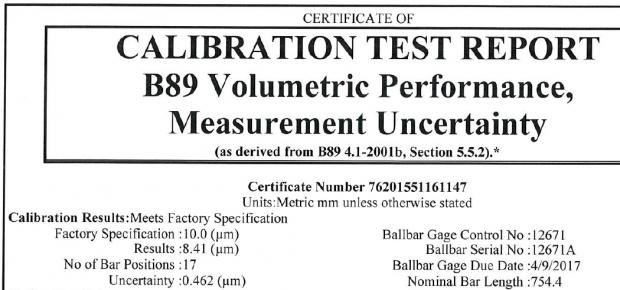Your Products have been synced, click here to refresh
Your Products have been synced, click here to refresh
First, look up the machine's Uncertainty spec on it's calibration report.
Note it's an uncertainty per-unit-of-measurement (usually meter?), so you have to math how much uncertainty for X length of measurement.
That had better waayyyy under 1/10th of your tightest tolerances.
Next, run some tests where you measure ring gauges and/or qual sphere over and over again in different positions with common stylus builds.
I like to dump the data to Excel for this, then crunch it for Range and Standard Deviation.
That will give you some realistic idea of how much uncertainty your machine is delivering, and is a good way to spot failing wrist/probe/stylus equipment too.
If that's over a tenth of your print tolerances, it's time to explain to mgmt that if they want to continue to bid on those kind of prints then they need to buy a better CMM, rarely a fun conversation.
Never report more decimal places than the machine's realistic uncertainty. It's typical to match or go one decimal place more than the print.
The CMM isn't a godlike purveyor of molecules, it's an industrial measuring machine - probably good to a couple microns.
Josh, so just to review and give others a look at the math, if I take a look at my cert for the Global with SP25 we have it showing Uncertainty of 0.462 (microns) to a ball bar length of 754.4.
So dividing the ball bar 754.4 / 1000mm =.7544 unit of measurement
Multiplying the unit of measurement times my uncertainty (.7544 * 0.462) = 0.3485328 microns
So if my smallest tolerance on that machine is 15 microns (times 10% or 0.10) = 0.0015mm =1.5 microns
Since the uncertainty (0.3485328 microns) is less than the 10 times less than my smallest tolerance (1.5 microns) I am good to go.
Am I looking at this correctly per your post or am I missing something here??
TIA, 4/1/96

Josh,
Here is a copy of the cert that I am referencing. This is from Hexagon Tech K. T. that was here in July 2015. So what I attached was listed as the volumetric performance, measurement uncertainty. There is also a page that lists Repeatability, Measurement uncertainty but that shows Uncertainty at 0.029 um, but also lists each individual axis X (0.45 um) Y (0.55 um) Z (0.37 um). Is that what you were referring to instead of volumetric uncertainty?
Report ID: b9c56c73-9016-e511-b48d-001372675f77
Certificate Number: 72601551161147
4/1/96
First, look up the machine's Uncertainty spec on it's calibration report.
Note it's an uncertainty per-unit-of-measurement (usually meter?), so you have to math how much uncertainty for X length of measurement.
That had better waayyyy under 1/10th of your tightest tolerances.
Next, run some tests where you measure ring gauges and/or qual sphere over and over again in different positions with common stylus builds.
I like to dump the data to Excel for this, then crunch it for Range and Standard Deviation.
That will give you some realistic idea of how much uncertainty your machine is delivering, and is a good way to spot failing wrist/probe/stylus equipment too.
If that's over a tenth of your print tolerances, it's time to explain to mgmt that if they want to continue to bid on those kind of prints then they need to buy a better CMM, rarely a fun conversation.
Never report more decimal places than the machine's realistic uncertainty. It's typical to match or go one decimal place more than the print.
The CMM isn't a godlike purveyor of molecules, it's an industrial measuring machine - probably good to a couple microns.
| © 2024 Hexagon AB and/or its subsidiaries. | Privacy Policy | Cloud Services Agreement |